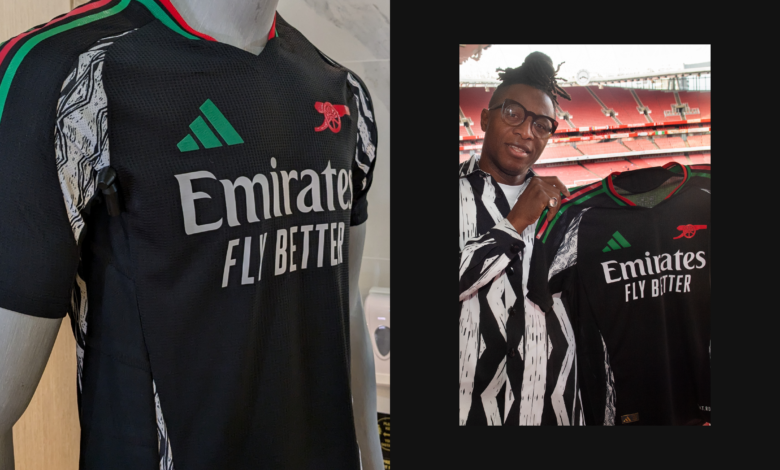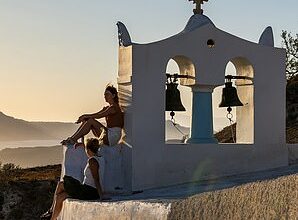Arsenal’s African-inspired away kit tells the story of their unique connection with black culture

Arsenal’s new away kit was designed by an immigrant.
Foday Dumbuya, founder and creative director of London menswear brand Labrum, wants you to know.
Forget the derogatory connotations imposed on people who have put down new roots in a country where they were not born, by those who wish to sow division. Dumbuya’s heritage is a point of pride, so much so that Labrum has used “designed by an immigrant” as a slogan on numerous products.
Working with Arsenal’s long-standing kit supplier Adidas, Labrum has kitted out manager Mikel Arteta’s team for next season’s away games, creating a kit that pays direct, conscious and unashamed tribute to the club’s players and fans shaped by the African diaspora.
Arsenal’s away kit is predominantly black with red and green detailing that mimics the Pan-African flag. The kit also features panels of a black and white zigzag design, intended to symbolize the flow of people emigrating from African countries in the 1920s and the art that came with it.
This isn’t a football kit that can only be worn by black people, but it is meant to tell a story. This project, which highlights Arsenal’s connection to black culture, wouldn’t be the same if it were any other Premier League club.

Arsenal’s 2024-25 away kit and accompanying collection (Daniel Barnes/The Athletic)
It is not new for fashion brands to collaborate with recognized manufacturers to create kits.
Juventus’ 2019-20 fourth kit was co-produced with Palace, Daily Paper lent its style to Ajax’s 2022-23 third shirt, Jamaica’s 2023 national team kits were made in collaboration with Wales Bonner, and last season AC Milan released two kits designed in collaboration with LA-based label Pleasures.
What makes Labrum’s association with Arsenal so special? For starters, this is the kit that Bukayo Saka, Martin Odegaard and co. are likely to wear at Old Trafford and Anfield in 2024-25.
This isn’t a throwaway collection to be quietly buried between season releases. As Arsenal’s primary away kit, it will be seen – and it’s designed to start a conversation about the club’s black influences.
“With Arsenal, they have a huge African fan base,” said Dumbuya, who was born in Sierra Leone and moved to London at the age of 12. “From the moment (Nwankwo) Kanu, (Emmanuel) Eboue, Kolo Toure and all those guys played for Arsenal, I think African fans are attracted to that because they can see themselves in those players.
“The next thing is, ‘How do we take this forward?’ Can we connect conversations and can we influence a community of people to understand Africa as a whole, to understand what it means to be black in London, Pan-Africanism and also the work that Arsenal has been doing for a while?

Arsenal’s new away kit (Daniel Barnes/The Athletic)
“Sometimes you teach yourself by seeing something and you have no idea what it means, but now you are pushed to go and investigate it. People talk about Pan-Africanism. Now it is in your face.”
The name Labrum is a Latin term that loosely translated means ‘having an edge’.
The clothing is inspired by West Africa and in 2023 Labrum won the Queen Elizabeth II Award for British Design, which Dumbuya received from King Charles.
Last year, ex-Arsenal and England striker Ian Wright walked the catwalk for Labrum at London Fashion Week. Chelsea’s Trevoh Chalobah has modelled for the brand. It has also designed clothes for Saka, Arsenal team-mate Reiss Nelson and former England international Rio Ferdinand.
When Netflix sponsored Hackney Wick FC — of the Eastern Counties First Division South, tier nine of the English football pyramid — Dumbuya designed their kits. Labrum also kitted out Sierra Leone at the Tokyo Olympics three years ago and will do so again, in partnership with Adidas, at this summer’s Games in Paris.

Ian Wright and England rugby star Maro Itoje modeled for Labrum at London Fashion Week (Getty Images)
Still, designing an African-inspired Arsenal kit feels like a milestone for Dumbuya, who founded Labrum in 2014 and expects to see his designs in a match for the first time when Arteta’s side play a friendly against Premier League club Bournemouth in Los Angeles on Wednesday (Thursday morning UK time) as part of a three-match pre-season tour of the US.
“I don’t know if another club had done this, if it would have reached the African fans, because they may not have a big African fan base,” Dumbuya says.
“When I spoke to Arsenal and Adidas, we saw that they have both always been pioneers in black culture and black history – from hip-hop to other cultural things – so we thought it was a relationship and a collaboration that was inevitable.
“They chose wisely to find a brand; not just because we’re big and loud, but more because we’re authentic and because we tell stories about where we’re from, about London and about West Africa. When things feel natural, people are drawn to them.”
How do you define the specific nuances of Arsenal’s connection to black culture?
Many clubs, of course, have black fans, but Arsenal’s unique relationship is unique and the result of a range of geological, social and cultural factors, including the various black heroes that countless generations of fans have seen play at the club’s former home ground of Highbury or the Emirates Stadium.

GO DEEPER
Arsenal: A North London heart with players who still feed the South London soul
“I’m not an Arsenal fan per se, but I certainly am one in the sense that I’m a Londoner and to be involved with black identity and black people, you have to have an association with Arsenal on some level, whether it’s in the schoolyard, in cultural spaces like the churches, the barbershop,” says Clive Chijioke Nwonka, senior lecturer in film, culture and society at University College London and co-editor of Black Arsenal, a forthcoming book exploring the club’s place in black British culture.

Arsenal players left for their US tour earlier this week wearing items from the Adidas Labrum collection (Stuart MacFarlane/Arsenal FC via Getty Images)
“This is a shirt that tries to celebrate what has been largely recognised, which is a movement towards Arsenal by people of the black diaspora over a number of years – not just recently – and it’s very natural that brands and manufacturers move into that kind of space and make it something that can be tangible and can be packaged for mass consumption.
“I think when we talk about and describe Black culture and the production of Black culture, we also have to be aware that what really matters is Black people and Black people’s experiences of that, which is often lost when we talk about brand culture.
“That said, I’m relieved that the final design was done by a black designer, because that hasn’t always been the case.”
Authenticity is important and Arsenal, Adidas and Labrum all have a responsibility to ensure their partnership resonates.
This can be especially difficult when a nod to culture is communicated through a piece of sportswear, a tangible item that people buy and wear.
The African diaspora is defined as the movement of people outside the continent and subsequently of people living elsewhere in the world who can trace their roots to Africa, regardless of whether that movement was voluntary or forced.
Expect to see this Arsenal away shirt. A lot. It’s bound to be popular and by 2024, football kits will have become a hot fashion item.

Foday Dumbuya, creative director of Labrum founder (Henry Nicholls/AFP via Getty Images)
It will also have some weight and nod to black culture regardless of who is wearing it and where they are from.
“I think this is something that we would find difficult to imagine and even accept if another club had done something similar, but that’s also why there needs to be some kind of ethics around it, and curation and description, because it can’t just be ‘business as usual – here’s another branded product’,” Nwonka says.
“I welcome the shirt and I celebrate the shirt because I know that this is something that is only possible through the optics and the lens of Arsenal, and no one else.
“I think the best way to describe it in a broad sense is that the Black Africa shirt is trying to capture and materialise what already exists or has already been expressed. They are not creating Black Africa. The Arsenal connection already exists. This is something that can now be disseminated and shared.
“Of course there is an economic dimension – but it is neither here nor there, because everything we do in terms of being a fan is in many ways a transaction – but it is capturing and packaging and in a way materializing what is already there, already expressed, already felt by people.”
“I want people to always remember the first club that celebrated their fans outside of their own territory and also highlighted everything about that specific territory, which was Africa as a whole,” said Labrum creator Dumbuya, who is an Arsenal fan himself.
“That’s never been done before. The players coming from abroad really changed this competition and added so much depth and culture, so when people remember the kit I hope they remember that — that it was a celebration of those players from the past and the African Arsenal fanbase.”

GO DEEPER
Why Arsenal are replacing the club crest on next season’s kits with the cannon
(Top photos: Adidas/Labrum)




